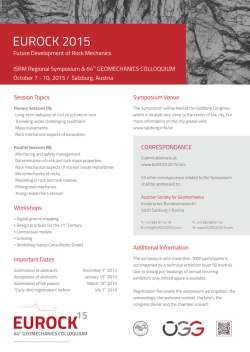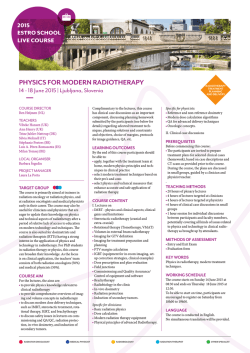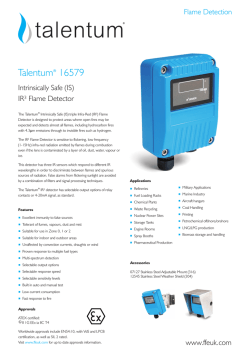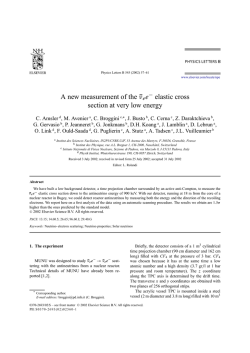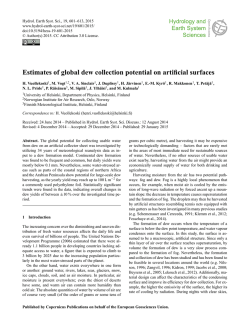
A new high background radiation area in the
Radiation Measurements 41 (2006) 602 – 610 www.elsevier.com/locate/radmeas A new high background radiation area in the Geothermal region of Eastern Ghats Mobile Belt (EGMB) of Orissa, India V.C. Baranwal a , S.P. Sharma a,∗ , D. Sengupta a , M.K. Sandilya b , B.K. Bhaumik b , R. Guin c , S.K. Saha c a Department of Geology and Geophysics, Indian Institute of Technology, Kharagpur, West Bengal 721 302, India b Physics Laboratory, Eastern Region, Atomic Minerals Directorate for Exploration and Research, Department of Atomic Energy, Jamshedpur 831002, India c Radiochemistry Division, Variable Energy Cyclotron Centre, BARC, Bidhan Nagar, Kolkata, West Bengal 700064, India Received 13 May 2005; received in revised form 21 November 2005; accepted 21 March 2006 Abstract A high natural radiation zone is investigated for the first time in a geothermal region of Eastern Ghats Mobile Belt (EGMB) of Orissa state in India. The surrounding area comprises a geothermal region which has surveyed using a portable pulsed Geiger–Muller counter. On the basis of findings of GM counter, an area was marked as a high radiation zone. Soil and rock samples collected from the high radiation zone were analyzed by -ray spectrometry (GRS) using NaI(Tl) detector. The radioactivity is found to be contributed mainly by thorium. Concentration of thorium is reported to be very high compared to their normal abundance in crustal rocks. Further, concentrations of 238 U and 40 K are also high compared to normal abundance in crustal rocks but their magnitude is comparatively less than that of thorium. The average concentrations of 238 U (i.e. U (.)), 232 Th and 40 K are found to be 33, 459 ppm and 3%, respectively, in soils and 312, 1723 ppm and 5%, respectively, in the granitic rocks. Maximum concentrations of 238 U, 232 Th and 40 K are found to be 95, 1194 ppm and 4%, respectively, in soils and 1434, 10,590 ppm and 8%, respectively, in the granitic rocks. Radioactive element emits various energies in its decay chain. High energies are utilized to estimate the concentration of actual 238 U, 232 Th and 40 K using a NaI(Tl) detector, however, low energies are used for the same in an HPGe detector. Some of the rock samples (eight in number) were also analyzed using HPGe detector for studying the behavior of low energies emitted in the decay series of uranium and thorium. The absorbed gamma dose rate in air and external annual dose rate of the high radiation zone are calculated to be 2431 nGy/h and 3.0 mSv/y, respectively. It is approximately 10 times greater than the dose rates obtained outside the high radiation zone. The high concentration of uranium and thorium may be one of the possible heat sources together with the normal geothermal gradient for hot springs present in the region. © 2006 Elsevier Ltd. All rights reserved. Keywords: Radioactivity; HBRA; Geothermal region; Granites; GM counter; Gamma ray spectrometry 1. Introduction Natural radioactive mineral deposits are found in suitable geological environment like unconformity contact, veins, surficial, etc. (Bhaumik et al., 2004). Their occurrences in outcrop enhance the background radiation of the area. This high exposure level may be harmful for people residing in the region. According to the United Nations Scientific Committee on Effects ∗ Corresponding author. Tel.: +91 3222 283386; fax: +91 3222 282268. E-mail address: [email protected] (S.P. Sharma). 1350-4487/$ - see front matter © 2006 Elsevier Ltd. All rights reserved. doi:10.1016/j.radmeas.2006.03.002 of Atomic Radiation Report (UNSCEAR, 2000), the greatest contribution to mankind’s exposure comes from natural background radiation, and the worldwide average annual effective dose is 2.4 mSv. However, much higher levels of exposure are usual for inhabitants of natural high background radiation areas (HBRAs). High radiation above the Earth is mainly due to naturally occurring radioactive elements in the Earth’s crust such as 238 U, 232 Th and 40 K. Areas at high altitudes are also affected by cosmic radiations (NCRP, 1987; UNSCEAR, 1993; Bennett, 1997). Radioactive elements are also very useful for mankind due to their different type of industrial and commercial uses. V.C. Baranwal et al. / Radiation Measurements 41 (2006) 602 – 610 603 Fig. 1. Map of the area showing location of the survey. Uranium and thorium may be found in naturally occurring minerals. Monazites, ilmenite, rutile, sillimanite and zircons, etc. are some heavy radioactive minerals which are found abundantly in India (Virnave, 1999). Monazite is one of the principal sources of rare-earth elements (REEs) and thorium in the continental crust. Thorium may be used as an important raw material in the production of nuclear power in India. 233 U, a fissile product, generated through irradiation of 232 Th, is used in fast breeder reactors (Mohanty et al., 2003). Rare-earth oxides (REOs) have wide applications in material science research and high-technology industries. Economically viable concentrations of radionuclides mostly occur in beach placer deposits. Generally coastal regions of various countries are designated as very HBRAs due to enrichment of radioactive placer deposits. Various HBRAs have been reported time to time from various parts of the world (NCRP, 1987; Wei et al., 1993; Paschoa, 2000; UNSCEAR, 2000; Ghiassi-nejad et al., 2002; Mohanty et al., 2004). Some of these areas have been under study in order to determine the risks and effects of long-term, low-level natural radiation exposure (Sohrabi, 1998). Ullal in Karnataka (Radhakrishna et al., 1993), Kalpakkam in Tamil Nadu (Kannan et al., 2002), coastal parts of Tamil Nadu and Kerala state, and the southwestern coast of India are known HBRAs in the Indian coastal region. Thorium-bearing minerals are found extensively in igneous complexes, mainly associated with the granites, syenites and pegmatite intrusive of all ages, however, the main resource base is confined to beach and inland placer deposits. Beach placer deposits occur at several places along both the eastern and western coasts of India. There are two appreciable concentrations of inland placers containing monazite: Ranchi plateau of Jharkhand and the Purulia planes of West Bengal in India (Virnave, 1999). Nonplacer-type thorium deposits occur in USA, Canada, Greenland, Brazil, South Africa, Uganda, Kenya, China and India (Overstreet, 1967; Virnave, 1999). These are associated with mainly carbonatite complexes, conglomerates, sandstones, granites, syenites and pegmatites. The study area is shown in Fig. 1. Previously, geophysical surveys using very low frequency electromagnetic, magnetic and resistivity surveys were carried out in the region near Tarbalu hot spring, Orissa (Baranwal and Sharma, 2005). A radiometric reconnaissance survey was also carried out in nearby regions using a portable pulsed Geiger–Muller (GM) counter and a relatively high natural background radiation region was identified. High concentration of radionuclides may be the source of heat responsible for the hot spring. A GM counter responds to and particles and -radiations from all the radionuclides (decay products of all the elements) and it is not possible to know about the particular element causing the radiation. Therefore, a laboratory measurement of soil and rock samples from the area was needed to determine the relative concentration of radioactive elements 238 U, 232 Th and 40 K contributing to the high radiation level. Soil and rock samples along four profiles (Fig. 1) were collected from a part of area showing high radiation (Fig. 2) and analyzed by -ray spectrometry (GRS) using NaI(Tl) and HPGe-type detectors. V.C. Baranwal et al. / Radiation Measurements 41 (2006) 602 – 610 18 400 17 320 10 100 100 240 0 16 200 Hot spring Chakradharprasad 160 80 10 0 15 Total radiation count 480 20 Latitude (20 deg. and minutes) 604 0 14 15 0 16 17 18 19 20 Longitude (85 deg. and minutes) Fig. 2. Contour map of radiation counting measured in the area (total counts per 100 s). Solid squares show the locations of the measured data. X- and Y -axis shows variation of longitude and latitude in minutes. Exact value should be read as 20◦ 14 N and 85◦ 15 E (taken from Baranwal and Sharma, 2005). 2. Geological setting The study area is near Tarbalu hot spring in Orissa, India. This area belongs to the Eastern Ghats metamorphic province and bounded by the latitude 20◦ 14 N to 20◦ 15.5 N and longitude 85◦ 14.5 E to 85◦ 19 E (Fig. 1). The area is characterized by high-grade (granulite facies) metamorphic rocks such as khondalite, charnockite, quartzofeldspathic gneisses, enderbites, with interlayered mafic horizons (Kundu et al., 2002). Granites and quartzofeldspathic gneisses mostly occur as flat sheet-like outcrops, in contrast to the more resistant, elevated domains of enderbites and khondalites. Granites are essentially abundant at the contact between enderbites and quartzofeldspathic gneisses. These granites cut across both rock units. In places, these coarse-grained granites have been subsequently deformed, as inferred from the crude alignment of biotite and flattened quartz grains. It is important to note that only these deformed granites coincide with zones of high radioactivity. The high radioactive zone is aligned along a roughly east–west trend, parallel to the enderbite hills, and passes through Chakradharprasad, Nimani and Arkhapalli villages (Fig. 1). The topography of the area is undulating; the high radiation zone is slightly elevated with respect to the surrounding country rock. Eight hot water spouts, distributed over an area of 0.01 km2 , with temperatures ranging between 47 and 85 ◦ C, have been reported in the area (Shanker, 1996). Tarbalu hot spring is approximately 4 km away from the high radiation zone delineated in the present study. 3. Experimental methods 3.1. Field survey and sample collection Since many hot springs are present in the area, therefore, to know the possible heat source feeding the hot springs, a radiometric survey was carried out using a portable pulsed GM counter at various locations covering an area about 78.75 km2 . Survey locations and contour of the total radiation are shown in Fig. 2. For detail radiometric survey over the high radiation zone, total radiation counts were again measured at 25 m interval along profiles 0000, 1200, 2400, 3600, 4800, 6000 and 7200 with profile spacing of 1200 m (Fig. 1). For each measurement, the sensor of GM counter was kept approximately 1 foot above the ground surface and operated for 100 s. This helped to have the appropriate geometry for subsequent sample collection. These profiles cover the area from Gobardhanprasad to Khuntaparha villages. Plotting of these profiles is shown in Figs. 3a–g. For laboratory assaying of the samples, rock and soil samples were collected along the profiles 2400, 3600, 4800 and 6000 at 200 m intervals. Some rock samples were also collected from the exposures along these profiles. Locations of rock and soil samples are marked by R1 and S1, respectively. However, rock samples are given extra notation i.e. a–c (e.g. R1a ) to show different rock types from the same location. For GRS, soil and rock samples were crushed to make it into a fine powder of size ∼ 508 m. Uranium analysis by . technique requires a further powdering to a size of ∼ 212 m. For GRS using NaI(Tl) detector, 200 g soil and rock samples were taken for the analysis. Some rock samples were also prepared in 10 g amount by coning and quartering method for subsequent analysis using high-purity germanium (HPGe) detector at VECC, Kolkata. For preparation of a sample of a specific amount from a bulk powder material by coning and quartering method, first of all, a cone shape is made by dropping powder material on a glass plate. The cone is spilt into four parts and two opposite parts are taken to mix them thoroughly, leaving the other two parts away from the plate. Again a cone shape is made in the same way and the process is repeated till the required amount is obtained. It is then kept in a sealed container for approximately one month period for attainment of equilibrium of radon daughter with the parent radium in the U-series. 3.2. Radiometric analysis 3.2.1. Gamma-ray spectrometry using NaI(Tl) The -ray spectrometric analysis using NaI(Tl) detector was carried out at physics laboratory of Atomic minerals directorate for Exploration and Research (AMD), Jamashedpur, Jharkhand. The samples were analyzed to estimate thorium concentration (Th), equivalent radium concentration Ra(eU3 O8 ), designated by Ra(eU) and potassium concentration (K) using four channel gamma ray spectrometer in which a 5 in × 4 in NaI(Tl) coupled to a 5 in diameter photomultiplier tube (PMT) integrated crystal is used as detector. The detector assembly was enclosed in a 4 in thick lead chamber. Details of the theory and instrumentation are discussed by Acharyulu et al. (2004). For estimation of K, Ra(eU) and Th, their corresponding energies i.e., 1.46, 1.76 and 2.62 MeV were used. For determination of concentration of K, Ra(eU), and Th, the windows were selected in the energy range of 1.36–1.56, 1.66–1.86 and 2.42–2.82 MeV, respectively. Channel stripping and sensitivities (i.e., rate of count per ppm) were calculated by using three standards namely; Th, U and K standards. In addition to this V.C. Baranwal et al. / Radiation Measurements 41 (2006) 602 – 610 605 sion for net rate of counts in channels (Bhauwmik et al., 2004). The gamma ray energies 1.76 MeV (from 214 Bi) and 2.62 MeV (from 208 TI) provide indirect estimate of 238 U and 232 Th, respectively. However, in geologic specimens, Th for all practical purposes, remains in equilibrium (only 50 years required for Th to attain equilibrium with its daughters). Therefore, measurement based on 2.62 MeV can give estimate of 232 Th. But for U, if the sample is not in equilibrium with respect to U-series, the measurement based on 1.76 MeV does not give the proper estimate of 238 U. Thus, the actual concentration of U is required to be determined based on simultaneous beta and total gamma counting (integral measurement i.e., no specific beta or gamma energy is used). The technique is described by Eichholz et al. (1953) and is designated by U(.). In this method, from the rate of gamma count (98% contribution comes from Ra group and 2% from uranium group of U-series), the amount of (eU3 O8 ) present in the sample is estimated. The rate of beta count is a sum contributed by both U-group and Ra-group of the U-series. From the calibration constant of the system i.e., rate of count per ppm, contribution in the rate of beta count by the estimated (eU3 O8 ) can be found out and therefore the contribution in the rate of beta count only due to U-group can be determined. This rate of beta count then provides an estimate of the actual concentration of uranium. The presence of thorium in the sample, which Eichholz et al. (1953) proved mathematically, is equivalent to an excess of radium, which contributes to both the rates of gamma and beta count. For a ratio even greater than 10 between Th and U, it is possible to obtain a good estimate of the concentration of uranium. The mathematical expression for estimating actual concentration of U is given by U = (1 + c)(eU3 O8 ) + c(eU3 O8 ) , (1) where ‘c’ is the ratio between the numbers of beta particles emitted by Ra-group to that of the U-group of a sample in equilibrium. The precision of estimates () is given by = (1 + c)2 {(eU3 O8 ) }2 + c2 {(eU3 O8 ) }2 . Fig. 3. Radiation counts per 100 s along the profiles (a) 0000, (b) 1200, (c) 2400, (d) 3600, (e) 4800, (f) 6000, (g) 7200. Dark region shows high radiation zone. there is an integral channel (400 keV–3 MeV) for counting of all the gamma photons. The data in this channel provide an estimation of (eU3 O8 ) , content of sample, which provides the combined contribution of all the radio elements. It is determined by the method of equivalence of gamma count between an equilibrium uranium standard and the sample. A similar quantity (eU3 O8 ) can be estimated by beta count equivalence also. The results of radiometric analysis are given in Table 1 with ±1 error due to statistical fluctuations (following Poisson statistics) in counting. They are calculated based on the expres- (2) Samples were also analyzed for actual concentration of uranium (designated as U(.)) using . technique (Eichholz et al., 1953). This technique gives the concentration of uranium irrespective of its state of equilibrium and presence of thorium. At a level of 100 ppm (eU3 O8 ) , the precision of estimate is 11%. All the concentrations i.e., U(.), Ra(eU) and Th are measured in ppm, however, K is shown in percentage of K2 O. Whenever, U or Th concentration of sample becomes very high, determination of 40 K is difficult due to Compton scattering giving poor precision of the measurements. Radioactivity in the study area is contributed primarily by thorium which is measured by NaI(Tl) detector at corresponding high energy of 2.62 MeV and to some extent by uranium. There is a series of various decay products of -ray emitters. 228Ac (having energies 209, 338 and 911 keV), 212 Bi (having energies 727 keV) are important -ray emitters in the decay chain of Th element. Since HPGe detector has very high resolution for low energies and it shows sharp peaks at corresponding 606 V.C. Baranwal et al. / Radiation Measurements 41 (2006) 602 – 610 Table 1 Concentration of U(.), Th, Ra(eU) and K2 O in soil and rock samples analyzed by -ray spectrometry using NaI(Tl) detector Type of sample Sample no. U( − ) (in ppm) Th (in ppm) Ra(eU) (in ppm) K2 O (in %) Soil samples - S1 S2 S3 S4 S5 S6 S7 S8 S9 S10 S11 S12 S13 S14 S15 S16 S17 S18 S19 S20 S21 S22 S23 S24 S25 S26 S27 * 43 ± 6 42 ± 3 5±1 23 ± 4 * * * 73 ± 4 14 ± 1 15 ± 2 33 ± 4 * 31 ± 5 71 ± 4 95 ± 6 57 ± 4 13 ± 2 47 ± 5 4±1 37 ± 4 2 16 ± 7 10 ± 1 2 * * 99 ± 3 268 ± 5 696 ± 10 376 ± 6 261 ± 4 161 ± 3 64 ± 2 87 ± 3 1194 ± 14 551 ± 8 566 ± 8 458 ± 7 51 ± 2 269 ± 5 1066 ± 13 832 ± 10 735 ± 10 443 ± 7 514 ± 8 203 ± 4 418 ± 7 792 ± 10 552 ± 8 351 ± 6 62 ± 2 32 ± 2 69 ± 2 * — 11 ± 1 6±1 7±1 7±1 3 3 12 ± 3 10 ± 2 9±1 11 ± 2 2 5±1 11 ± 2 22 ± 2 22 ± 2 6±1 7±2 5±1 8±1 48 ± 3 59 ± 2 28 ± 2 4 4 7±1 1.5 ± 0.1 2.7 ± 0.2 2.7 ± 0.2 2.3 ± 0.2 1.5 ± 0.1 1.1 ± 0.1 2.6 ± 0.1 3.0 ± 0.1 3.7 ± 0.3 2.4 ± 0.2 2.6 ± 0.2 2.2 ± 0.2 2.8 ± 0.1 3.3 ± 0.2 4.0 ± 0.3 2.1 ± 0.3 1.8 ± 0.2 2.7 ± 0.2 3.6 ± 0.2 2.3 ± 0.1 2.6 ± 0.2 1.0 ± 0.2 — 1.6 ± 0.2 2.6 ± 0.1 1.5 ± 0.1 2.4 ± 0.1 Rock samples Granite R1a 20 ± 2 653 ± 9 7±1 7.1 ± 0.2 Mafic layer R1b * 20 ± 1 2 2.9 ± 0.1 Granite R1c * 157 ± 3 3 4.6 ± 0.1 Enderbite R2a * 59 ± 2 2 3.4 ± 0.1 Granite R2b R3a R4a R4b R4c R5a R5b R5c R6a R7a R7b 96 ± 8 549 ± 8 25 ± 2 4.6 ± 0.2 * 146 ± 3 2 6.3 ± 0.1 * 18 ± 1 2 0.9 ± 0.1 Granite Enderbite Granite Granite QFG Granite Granite Granite QFG Granite 1434 ± 22 10590 ± 102 338 ± 19 7.5 ± 2.0 238 ± 11 1228 ± 14 185 ± 4 — * 27 ± 2 1 3.3 ± 0.1 * 97 ± 3 10 ± 1 0.2 39 ± 1 3080 ± 30 44 ± 5 3.1 ± 0.6 * 366 ± 6 4±1 5.8 ± 0.2 * 20 ± 1 2 1.2 ± 0.1 44 ± 5 366 ± 6 4±1 5.8 ± 0.2 ‘*’ indicates error in the analysis to be more than 10%.‘-’ indicates insignificant concentration.QFG—Quartzofeldspathic Gneiss. energies of its decay products, therefore, a few samples (eight in numbers) were also analyzed using an HPGe detector. HPGe detector generates full spectrum of the sample’s decay products instead of counting the gamma rays of a particular energy range (set as window) in NaI(Tl). In case of NaI(Tl) detector, efficiency is high, however, resolution is high in case of HPGe detector. There may be relative migration of the isotopes of radionuclides which may show discrepancy in measurements by NaI(Tl) detector. However, energy peaks corresponding to various decayed isotopes can be seen clearly by use of an HPGe detector. 3.2.2. Gamma-ray spectrometry using HPGe The gamma-ray spectrometric analysis using a coaxial HPGe detector (EG & G, ORTEC) with a 15% relative efficiency was carried out at the Radiochemistry Division, Variable Energy V.C. Baranwal et al. / Radiation Measurements 41 (2006) 602 – 610 607 Table 2 Concentration of Th revealed by various low energies emitted by its decay products in -ray spectrometry using HPGe detector Type of rock Sample Concentration of Th (in ppm) revealed by various low energies emitted due to the decay products no. 239 keV (212 Pb) 338 keV (228Ac) 583 keV (208 Tl) 727 keV (212 Bi) 911 keV (228Ac) Average concentration Granite R2b 550 ± 30 547 ± 36 497 ± 28 310 ± 22 546 ± 30 490 ± 29 Enderbite R4a R4b R4c R5c R6a R7a R7b 29 ± 2 42 ± 4 62 ± 4 43 ± 4 50 ± 3 45 ± 3 9946 ± 536 9472 ± 512 8557 ± 462 9519 ± 519 9288 ± 504 9356 ± 507 1159 ± 63 1114 ± 63 1010 ± 55 1317 ± 77 1132 ± 62 1146 ± 64 2475 ± 134 2780 ± 154 2511 ± 137 3064 ± 174 2671 ± 146 2700 ± 149 377 ± 21 362 ± 25 291 ± 16 296 ± 20 311 ± 17 327 ± 20 44 ± 3 70 ± 6 42 ± 3 31 ± 2 15 ± 2 40 ± 3 397 ± 22 556 ± 37 401 ± 22 262 ± 19 430 ± 24 409 ± 25 Granite Granite Granite Granite QFG Granite 212Pb 20000 208Tl Net counts 228Ac 15000 228Ac 10000 214Pb 212Bi 214Pb 5000 40K 214Bi 0 100 300 500 700 900 Energy (keV) 1100 1300 1500 Fig. 4. -ray spectrum of granitic rock sample R4b counted using HPGe detector. Counts at 238 keV (212 Pb) and 583 keV (208 Tl) are 16,709 and 21,658, respectively. Cyclotron Centre BARC, Kolkata. The detector was placed in a 10 cm shield of lead bricks to reduce background radiation caused by building materials and cosmic rays. The detector was cooled to liquid-nitrogen temperatures and coupled to a PC-based 8K multi-channel analyzer with appropriate software for data acquisition and analysis developed by Bhabha Atomic Research Centre (BARC), India. The absolute efficiency of the detector was determined with a 152 Eu liquid source detector (Amersham International Company, UK). The 152 Eu liquid source was thoroughly mixed with the normal silica sands, whose activity level was similar to the background radiation level. An ideal measuring geometry of a cylindrical source (homogeneously distributed activity with constant volume and distance) was placed coaxially with the detector for the efficiency determination and the same procedure applied for the sample measurements. The sample was sealed and stored for a period of one month in a tight container to attain radioactive equilibrium in the decay chains (Evans, 1969). The samples were subsequently assayed by GRS using a high-resolution HPGe detector having a resolution of 1.9 keV at 1332 keV photo peak of 60 Co. 232 Th is not a direct gamma ray emitter but gamma rays of their decay product can be measured. Decay products for 232 Th i.e., 228Ac (energies 338 and 911 keV), 212 Pb (energy 239 keV), 212 Bi (energy 727 keV), and 208 Tl (energy 583 keV) were used to estimate the thorium concentration assuming the decay series to be in secular equilibrium (Firestone and Shirley, 1998). Instead of one gamma, we used several gamma rays and finally an average value is mentioned in the results provided (Table 2). The counting time for each sample was 80,000 s. The activity concentration is calculated from HPGe data using the relation A = peak area/(t ∗ ∗ %yield), where ‘t’ is the collection time and is the efficiency. Thus, one can calculate that 1 ppm of thorium corresponds to 4.04 Bq/kg activity. There may be various errors in estimation due to a number of factors, like geometry of the sample, efficiency determination, peak area determination and random uncertainties associated with background and sample counts. Main sources of errors are efficiency calculation (up to 5%, including error due to geometry also), weighing error (up to 2%) and peak area calculation (up to 2 %). A fixed error of 5% in efficiency calculation and 2% in weighing are considered to calculate total error in measurement, however, error in peak area estimation was different for various energies. A gamma ray spectrum of granitic rock sample, R4b recorded using HPGe detector is presented as an example (Fig. 4), showing the gamma lines from various daughter radionuclides of 232 Th. 608 V.C. Baranwal et al. / Radiation Measurements 41 (2006) 602 – 610 3.3. Absorbed gamma dose rate measurement The absorbed gamma dose rate in air 1 m above the ground surface for the uniform distribution of radionuclides (232 Th, 238 U, 40 K) can be computed on the basis of guidelines provided by UNSCEAR (1993, 2000). We assumed that the contribution from other radionuclides, such as 137 Cs, 235 U, 87 Rb, 90 Sr, 138 La, 147 Sm and 176 Lu to the total dose rate is negligible. The conversion factors used to compute absorbed gamma dose rate (D) in air per unit activity concentration in 1 Bq/kg material corresponds to 0.621 nGy/h for 232 Th, 0.462 nGy/h for 238 U and 0.0417 nGy/h for 40 K. Expression to calculate the dose rate can be given as D = (0.621CTh + 0.462CU + 0.0417CK ) nGy/h, (3) where CTh , CU and CK are the average activity concentrations of 232 Th, 238 U and 40 K in Bq/kg, respectively. If concentrations are taken in units of ppm then the formula can be re-written as D = (2.51CTh + 5.71CU + 10.51CK ) nGy/h. (4) To estimate the annual effective dose rates, the conversion coefficient from absorbed dose in air to effective dose (0.7 Sv/Gy) and outdoor occupancy factor (0.2) proposed by UNSCEAR (2000) is used. The effective dose rate in units of mSv/y may be calculated using the following formula (Matiullah et al., 2004) effective dose rate (mSv/y) = 1.23 × 10−3 × dose rate. (5) 4. Results and discussion Radiation counts measured by a portable GM counter is shown in Figs. 3a–g along the profile lines 0000, 1200, 2400, 3600, 4800, 6000 and 7200, respectively. For comparison of the total radiation counts, all the profiles are plotted on the same scales. Profiles 0000, 1200 and 7200 (Figs. 3a–c) show almost consistent nature and not varying much from background radiation count, approximately 50 counts per 100 s. However, profiles 2400, 3600, 4800 and 6000 (Figs. 3c–e) show a high radiation zone at 200–1000 m distance on each profile. Maximum value of the count is approximately 650 counts/100 s along the profiles 3600, 4800 and 6000. The width of the high radioactive zone is largest along the profile 4800 and varies from 200 to 1400 m. Because the GM counter responds to , and -radiations of various energies, it is not possible to know about the particular radioactive elements responsible for such anomalous radiations as shown by the counter. Therefore, soil and rock samples were collected subsequently along these profiles for laboratory assaying by GRS. All the soil and rock samples are analyzed by GRS using NaI(Tl) detector, however, a few rock samples were also analyzed by a HPGe detector to observe the peaks of low energies corresponding to decay products of thorium. Concentration of thorium is calculated by assuming a secular equilibrium among the various isotopes of Th-series. Results of all the rock and soil samples analyzed using NaI(Tl) detector are summarized in Table 1 and the results of rock samples analyzed by use of HPGe detector are summarized in Table 2. Fig. 5. Concentration of thorium in the soil samples along the profiles (a) 2400, (b) 3600, (c) 4800, (d) 6000, analyzed by -ray spectrometry using NaI(Tl) detector. The error of estimation by NaI(Tl) detector is less than 2% in case of thorium. However, error in measurement for concentration of uranium is high for samples of low activities. This higher error occurs due to low statistics in counting for low activity samples. When concentration of eU3 O8 is less than 100 ppm then error in estimation of uranium will increase significantly (Acharyulu et al., 2004). For some samples, concentration of the element is not mentioned in Table 1 if the error was more than 10%, however, an asterisk mark (*) is mentioned there. In some samples, concentration of elements was very low and insignificant, therefore a hyphen (-) is mentioned there. It is clear from Table 1 that thorium (232 Th) concentration is very high in comparison to 238 U and 40 K elements. Since, regular rock exposures were not available along the profiles 2400, 3600, 4800 and 6000, therefore, soil samples were collected at equidistant points along these profiles. Concentrations of thorium in soil samples along various profiles are plotted and shown in Fig. 5. Maximum concentration of thorium in soil sample is reported as 1194 and 1066 ppm in the sample S9 and S15 along the profiles 3600 and 4800, respectively. These samples were collected at 400 m location on respective profiles. V.C. Baranwal et al. / Radiation Measurements 41 (2006) 602 – 610 Fig. 3 also shows maximum radiation count at 400 m location on the same profiles (3600 and 4800, Figs. 3d and e). However, moving further away from the 400 m location (profiles 3600 and 4800, Figs. 5b and c), the concentration of thorium is decreasing. Profile 6000 (Fig. 5d) shows high concentration of thorium at its starting point due to the presence of rock exposures containing radioactive elements at this location. The average concentrations of 238 U (i.e., U(.)), 232 Th and 40 K in soil are calculated as 33, 459 ppm and 2.5%, respectively. Maximum concentrations of 238 U (i.e., U(.)), 232 Th and 40 K in soil are calculated as 95, 1194 ppm and 4%, respectively. Rock types for the various samples studied are also mentioned in Table 1. Locations of rock samples are shown in Fig.1. In the area, three types of rocks, quartzofeldspathic gneiss, enerbites and granites are found. Different rocks collected from same exposure are distinguished by superscripts a, b and c (e.g., R1a ). High concentration of thorium is reported only for the granitic rocks (see Table 1). In host rocks, quartzofeldspathic gneiss and enderbite thorium activity is very less and can be assumed insignificant (R1b , R2a , R4a , R5a and R7a ; Table 1). Granitic rock samples, R1a , R5b , R7b , R2b and R6a along the profiles 1200, 2400, 3600 4800 and 6000, respectively show high concentration of thorium. Rock samples collected from the nearby regions along these profiles also show high concentration of thorium which indicates a good agreement between concentration of thorium in rocks and soil samples. This suggests about the possibility of formation of soil by weathering of these rocks. Rock sample, R4b , collected from the foot of the nearby hills exhibits maximum concentration of thorium (10,590 ppm) from the region. Uranium concentration in this sample was also relatively high. The average concentrations of 238 U (i.e., U(.)), 232 Th and 40 K in granitic rock are calculated as 312, 1723 ppm and 5%, respectively. Maximum concentrations of 238 U (i.e., U(.)), 232 Th and 40 K in granitic rock are calculated as 1434, 10,590 ppm and 7 %, respectively. The average concentrations of U(.), 232 Th and 40 K in high radiation zone are calculated as 100, 728 ppm and 3%, respectively. In the soil samples collected outside the high radiation zone (Samples S26 and S27 ; Fig. 1), the average concentrations of U(.), 232 Th and 40 K are 50, 12 ppm and 5%, respectively. The absorbed gamma dose rate in the air and external annual effective dose rate are also calculated using Eqs. (4) and (5). The absorbed gamma dose rate and annual effective dose rate outside the high radiation zone are 248 nGy/h and 0.31 mSv/y, respectively. In high radiation zone, absorbed gamma dose rate and annual effective dose rate are 2431 nGy/h and 2.99 mSv/y, respectively. Dose rates in the high radiation zone are approximately 10 times greater than the dose rates outside the high radiation zone in this region. A few rock samples were analyzed using HPGe detector. All the samples showed energy peaks of the corresponding decayed isotopes of 232 Th, 238 U and 40 K clearly. A -ray spectrum of granitic rock sample, R4b is shown in Fig. 4. 212 Pb, 228Ac, 208 Tl, 212 Bi and 228Ac are decay products of thorium and show sharp peak at -energies 239, 338, 583, 727 and 911 keV, respectively. 214 Pb, decay product of uranium shows sharp -peak at 609 energies 295 and 352 keV and 214 Bi, also a decay product of uranium shows sharp peak at 609 keV. 40 K shows a -peak at 1459.2 keV. Concentration of 232 Th is also calculated assuming a secular equilibrium among the various isotopes of thorium corresponding to various energies and tabulated in Table 2. The results are consistent for different energies from the same sample with the results obtained using the NaI(Tl) detector. Tarbalu hot springs are present at a distance of 4 km in the east direction from the high radiation zone (Figs. 1 and 2). Baranwal and Sharma (2005) carried out integrated geophysical study using a very low frequency EM, magnetic, resistivity and radiometric survey around the hot spring. Resistivity, VLF and magnetic interpretation are suggested for shallow fracture zones. Self-potential survey carried out in the area does not suggest the presence of any mineral body. Self-potential data also does not support any upflow of hot water from greater depth below the hot spring. Small positive self-potential anomaly suggests possible lateral movement of hot water. Tectonothermal activities and deep magma chamber have not been reported in earlier geological studies carried out in the area. These geophysical studies indicate the presence of fracture zones near the hot spring and suggest the possibility of the radiogenic heating in the region. High concentration of thorium reported in the rock and soil samples in the present study supports the possibility of radiogenic heating in the region. Water contained in high heat production granites is likely to set into convective circulation (Durrance, 1986). 5. Conclusions A high background radiation zone is identified in a geothermal region of Eastern Ghats Mobile Belt (EGMB) on the basis of radiometric profiling of the area using a portable pulsed GM counter. Soil and rock samples collected from the high radiation zone showed mainly high concentration of thorium. Therefore, background of the area is enhanced to high radiation due to presence of primarily thorium in rocks and soils. Presence of thorium in rock and soil samples suggests that soils are formed by weathering of the ambient rocks. A good correlation between radiation counts measured by GM counter and thorium concentration determined by GRS is also reported (Figs. 3 and 5). Error in estimation for thorium is within 2% for all the samples, whereas it is high for uranium estimations. A few rock samples analyzed by HPGe detector also show distinct energy peaks corresponding to various isotopes in the decay chain of thorium. Corresponding energy peaks also confirm presence of abundant thorium in the area. Concentrations of thorium measured by both methods also match within the limit of the experimental error. The absorbed gamma dose rate in air and external annual dose rate of the high radiation zone are calculated as 2431 nGy/h and 2.99 mSv/y, respectively. It is about 10 times greater than the dose rates outside the high radiation zone. High concentration of thorium reported in the rock and soil samples supports the possibility of radiogenic heating in the region to be an important contributor to the subsurface heat flow. Normal geothermal gradient may 610 V.C. Baranwal et al. / Radiation Measurements 41 (2006) 602 – 610 also be one of the reasons for hot spring, moreover, presence of very deep fractures (> 4 km) will support for such a possibility. References Acharyulu, A.A.P.S.R., Murty, B.S., Bhaumik, B.K., 2004. Enrichment characteristics of radioelements in various types of rock from Sambalpur district, Orissa, India. Proc. Indian Acad. Sci. (Earth Planet. Sci.) 113, 321–352. Baranwal, V.C., Sharma, S.P., 2005. Integrated geophysical studies in the East-Indian Geothermal Province. Pure Appl. Geophys. 163, 209–227. Bennett, B.G., 1997. Exposure to natural radiation worldwide. In: Proceedings of the Fourth International Conference on High Levels of Natural Radiation: Radiation Doses and Health Effects, Beijing, China, 1996. Elsevier, Tokyo, pp. 15–23. Bhaumik, B.K., Bhattacharya, T., Acharyulu, A.A.P.S.R., Srinivas, D., Sandilya, M.K., 2004. Principles of Radiometry in Radioactive Metal Exploration. Physics Lab, Eastern Region, AMD Complex, Jamshedpur, India, 292pp. Durrance, E.M., 1986. Radioactivity in Geology: Principles and Applications. Ellis Horwood Limited, Chichester, UK, pp. 143–162. Eichholz, G.G., Hilborn, J.W., McMahon, C., 1953. The determination of uranium and thorium in ores. Can. J. Phys. 31. Evans, R.D., 1969. The Atomic Nucleus. McGraw-Hill, New York. p. 927. Firestone, R.B., Shirley, V.S., 1998. Table of Isotopes. eighth ed.. Wiley, New York. Ghiassi-nejad, M., Mortazavi, S.M.J., Cameron, J.R., Niroomand-rad, A., Karam, P.A., 2002. Very high background radiation areas of Ramsar, Iran: preliminary biological studies. Health Phys. 82, 87–93. Kannan, V., Rajan, M.P., Iyengar, M.A.R., Ramesh, R., 2002. Distribution of natural and anthropogenic radionuclides in soil and beach sand samples of Kalpakkam (India) using hyper pure germanium (HPGe) gamma ray spectrometry. Appl. Radiat. Isot. 57, 109–119. Kundu, N., Panigrahi, M.K., Sharma, S.P., Tripathy, S., 2002. Delineation of fluoride contaminated groundwater around a hot spring in Nayagarh, Orissa, India using geochemical and resistivity studies. Environ. Geol. 43, 228–235. Matiullah, A.A., Rehman, S., Rehman, S., Faheen, M., 2004. Measurement of radioactivity in the soil of Bahawalpur division Pakistan. Radiat. Prot. Dosim. 112 (3), 443–447. Mohanty, A.K., Das, S.K., Vijayan, V., Sengupta, D., Saha, S.K., 2003. The geochemical studies of monazite sands of Chhatrapur beach placer deposit of Orissa, India by PIXE and EDXRF method. Nucl. Instrum. Methods Phys. Res. B 211, 145–154. Mohanty, A.K., Sengupta, D., Das, S.K., Saha, S.K., Van, K.V., 2004. Natural radioactivity and radiation exposure in the high background area at Chhatrapur beach placer deposit of Orissa, India. J. Environ. Radioact. 75, 15–33. NCRP, 1987. Exposure of the population of the United States and Canada from natural background radiation. Report no. 94. National Council on Radiation Protection and Measurements, Bethesda, MD. Overstreet, W.C., 1967. The geological occurrence of monazite. US Geological Survey Professional Paper 530, p. 327. Paschoa, A.S., 2000. More than forty years of studies of natural radioactivity in Brazil. Technology 7, 193–212. Radhakrishna, A.P., Somasekarapa, H.M., Narayana, Y., Siddappa, K., 1993. A new natural background radiation area on the southwest coast of India. Health Phys. 65, 390–395. Shanker, R., 1996. Development of geothermal resources in India: possibilities and constraints. In: Pitale, U.L., Padhi, R.L. (Eds.), Geothermal Energy in India, GSI Pub. No. 45, pp, 1–5. Sohrabi, M., 1998. The state-of-the-art on worldwide studies in some environments with elevated naturally occurring radioactive materials NORM. Appl. Radiat. Isot. 49, 169–188. UNSCEAR, 1993. Sources and Effects of Ionizing Radiation. United Nations Scientific Committee on the Effect of Atomic Radiation, United Nations, New York. UNSCEAR, 2000. Sources and Effects of Ionizing Radiation. United Nations Scientific Committee on the Effect of Atomic Radiation, United Nations, New York. Virnave, S.N., 1999. Nuclear Geology and Atomic Mineral Resources. Bharti Bhawan, Patna, India. Wei, L., Zha, Y., Tao, Z., He, W., Chen, D., Yuan, Y., 1993. Epidemiological investigation in highbackground radiation areas in Yangjiang, China. In: Proceedings of the International Conference on High Levels of Natural Radiation Areas, Ramsar, Iran, 1990. IAEA Publication Series, IAEA, Vienna, pp. 523–547.
© Copyright 2025

